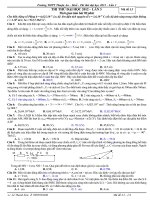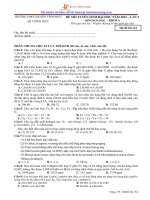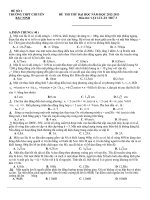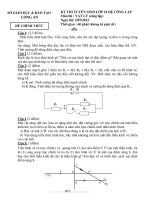Đề thi Lý thuyết Asian Physics Olympiad 2012 Bài 3 môn vật lý
Bạn đang xem bản rút gọn của tài liệu. Xem và tải ngay bản đầy đủ của tài liệu tại đây (604.83 KB, 4 trang )
Theory Question
Page 1 of 4
13
th
Asian Physics Olympiad
May 01-07, 2012, New Delhi
III
Pancharatnam Phase
This problem deals with the two beam phenomena associated with light, its
interference, polarization and superposition. The particular context of the problem
was studied by the Indian physicist S. Pancharatnam (1934–1969).
Consider the experimental set up as shown in Fig. (1). Two coherent monochromatic light
beams (marked as beam 1 and 2), travelling in the direction, are incident on two narrow
slits and separated by a distance (
1
2
= ). After passing through the slits the two
beams interfere and the pattern is observed on the screen . The distance between the slits
and the screen is and . Assume that the width of each slit
1
and
2
is much
smaller than the wavelength of light.
III.1. Let the beams 1 and 2 be linearly polarized at = 0. The corresponding
electric field vectors are given by
where is the unit vector along the -axis, is angular frequency of light and
0
is
the amplitude. Find the expression for the intensity of the light
, that will be
observed on the screen where is the angle shown in Fig. (1). Express your answer
in terms of , ,
0
, and where is the speed of light. Also, note that the
intensity is proportional to the time average of the square of the electric field. Here
you make take the proportionality constant to be . You may ignore the attenuation
in the magnitude of the electric fields with distance from the slits to any point on
the screen.
[1.0 point]
III.2. A perfectly transparent glass slab of thickness and refractive index is
1
=
0
cos()
…………………(1a)
2
=
0
cos()
…………………(1b)
Figure 1
S. Pancharatnam
(1934–1969)
Theory Question
Page 2 of 4
13
th
Asian Physics Olympiad
May 01-07, 2012, New Delhi
III
introduced in the path of beam 1 before the slits. Find the expression for the
intensity of the light
that will be observed on the screen. Express your answer
in terms of , ,
0
, , , and .
[1.0 point]
III.3. An optical device (known as quarter wave plate (QWP)) is introduced in the
path of beam 1, before the slits, replacing the glass slab. This device changes the
polarization of the beam from the linear polarization state
to a circular polarization state which is given by
where is the unit vector along the -axis.
Assume that the device does not introduce any additional path difference and that
it is perfectly transparent. Note that the tip of the electric field vector traces a
circle as time elapses and hence, the beam is said to be circularly polarized. We
assume that the angle is small enough so that intensity from slit one does not
depend on the angle even for polarization.
III.3.a. Find the expression for the intensity
of the light that will be observed
on the screen. Express your answer in terms of , ,
0
, and .
III.3.b. What is the maximum intensity (
)?
III.3.c. What is the minimum intensity (
)?
[2.0 points]
III.4.
Now, consider the experimental setup (see Fig. (2)) in which the beam 1 is subjected to
the device (QWP) described in part 3 and,
a linear polarizer (marked as I), between = and = which allows only
the component of the electric field parallel to an axis () to pass through. The
1
=
0
cos()
1
=
1
2
0
cos() +
0
sin()
…………………(2)
Figure 2
Theory Question
Page 3 of 4
13
th
Asian Physics Olympiad
May 01-07, 2012, New Delhi
III
unit vector is defined as
= cos + sin
and,
another linear polarizer (marked as II) between = and = which
polarizes the beam back to direction.
Thus the beam 1 is back to its original state of polarization. Assume that the
polarizers do not introduce any path difference and are perfectly transparent.
III.4.a. Write down the expression for the electric field of beam 1 after the first
polarizer at = [
1
( = )].
III.4.b. Write down the expression for the electric field of beam 1 after the
second polarizer at = [
1
( = )].
III.4.c. What is the phase difference () between the two beams at the slits?
[2.0 points]
The most general type of polarization is elliptical polarization. A convenient way of
expressing elliptical polarization is to consider it as a superposition of two orthogonal
linearly polarized components i.e.
where and and this state of polarization are depicted in Fig. 3.
The tip of the electric field vector traces an ellipse
as time elapses. Here represents the ellipticity
and is given by
tan =
Semi-minor axis of the ellipse
Semi-major axis of the ellipse
Linear polarization (Eqs. (1)) and circular
polarization (Eq. (2)) are special cases of elliptical
polarization (Eq. (3)). The two parameters
( [0, ])and ( [/4, /4]) completely
describe the state of polarization.
=
0
cos cos() +
0
sin sin()
…………………(3)
Figure 3
Theory Question
Page 4 of 4
13
th
Asian Physics Olympiad
May 01-07, 2012, New Delhi
III
The polarization state can also be represented by
a point on a sphere of unit radius called the
Poincare sphere. The polarization of the beam
described in Eq. (3) is represented by a point
on the Poincare sphere (see Fig. 4), then latitude
= 2 and longitude = 2. Here
is the center.
III.5. Consider a point on the equator of the Poincare sphere.
III.5.a. Write down the electric field (
Eq
) corresponding to this point.
III.5.b. What is its state of polarization?
[0.5 point]
III.6. Consider a point at the north pole of the Poincare sphere.
III.6.a Write down the electric field (
NP
) corresponding to this point.
III.6.b What is its state of polarization?
[0.5 point]
III.7. Now, consider the three polarization states of beam 1 as given in part 4. Let
the initial polarization (at = 0) be represented by a point
1
on the Poincare
sphere; after the optical device, let the state (at = ) be represented by point
2
and after the first polarizer (say, at = ), the state be represented by point
3
. At
= , the polarization returns to its original state which is represented by
1
.
Locate these points (
1
,
2
, and
3
) on the Poincare sphere.
[1.5 points]
III.8. If these three points (
1
,
2
, and
3
from the part (III.7)) are joined by great
circles on the sphere, a triangle on the surface of the sphere is obtained (Note: A
great circle is a circle on the sphere whose center coincides with the center of the
sphere). The phase difference obtained in part 4 and the area of the curved
surface enclosed by the triangle are related to each other. Relate to .
This relationship is general and was obtained by Pancharatnam and the phase difference is called
the Pancharatnam phase. [1.5 points]
Figure 4









